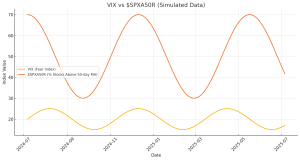📉 What is the VIX?
The VIX measures the market’s expected annualized volatility over the next 30 days, derived from prices of S&P 500 index options russellinvestments.com+15en.wikipedia.org+15chartschool.stockcharts.com+15.
Values below ~20 generally suggest market calm, while readings above ~30 signal elevated fear investopedia.com.
Trailing 12‑Month Average
- According to Investing.com, over the past 12 months, the VIX had a high of 22.75, low of 16.11, and a mean of approximately 18.75 spglobal.com+13investing.com+13investopedia.com+13.
- Another benchmark: the long‑term average from 2015–2025 was just above 19 investopedia.com.
This suggests that recent volatility levels have been slightly below the typical 1‑year average—consistent with a relatively calm market environment.
Past 30 Days (Trailing One Month)
Based on daily figures from late May through June 2025 from Investing.com and FRED:
- Recent daily VIX closes: high of ~22.17, low of ~16.11.
- Looking at the Investing.com data for mid-May to mid-June, the monthly average comes out to approximately 19 cboe.com+15investing.com+15kensingtonassetmanagement.com+15fred.stlouisfed.org.
So the past 30‑day average (~19) is just slightly above the 12‑month average (~18.75), reflecting some mild volatility as compared to the subdued longer-term mean.
📈 Interpreting the Charts & Trends
- Historical context: The VIX has spiked near or above 20–25 during periods of stress and fallen into a 10–15 range in calmer times chartschool.stockcharts.com.
- Mean reversion: Volatility tends to move toward its long-term average—these recent averages imply the VIX is in a neutral zone, neither excessively low nor panic‑high .
- Overestimation premium: Historically, the VIX tends to overstate future volatility by ~4–5 percentage points versus realized VIX, when measured over 252 trading days (~1 year) spglobal.com.
| Average Monthly VIX (December 2024 - November 2025) | |
| December 2024 | 15.22 |
| January 2025 | 16.58 |
| February 2025 | 17.29 |
| March 2025 | 21.52 |
| April 2025 | 35.90 |
| May 2025 | 20.54 |
| June 2025 | 18.63 |
| July 2025 | 18.12 |
| August 2025 | 16.38 |
| September 2025 | 15.17 |
| October 2025 | 18.58 |
| November 2025 | 20.78 |
| 30-Day Weekly VIX (October 24, 2025 - November 21, 2025) | |
| October 24, 2025 | 16.37 |
| October 31, 2025 | 17.44 |
| November 07, 2025 | 19.08 |
| November 14, 2025 | 19.83 |
| November 21, 2025 | 23.43 |
Visualizing Market Fear: See VIX Charts in Action
Understanding the data behind the Fear Index is essential, but seeing the CBOE Volatility Index (VIX) in visual form brings the story to life. Charts allow us to spot patterns, identify major spikes in investor fear, and compare historical reactions to key market events. Whether you’re monitoring for short-term volatility or evaluating longer-term sentiment trends, a visual representation of the VIX is an indispensable part of any trader’s toolkit.
For swing traders, these charts can highlight key inflection points—such as when fear peaks and begins to subside—which often coincide with market bottoms or reversals. At Above the Green Line, we closely watch VIX levels in conjunction with our technical strategies to help identify high-probability buying opportunities when panic selling has likely peaked.
If you’re looking to take your understanding of market sentiment a step further, we encourage you to view the live and historical VIX charts linked below. These charts provide an interactive way to explore how volatility behaves over time and how it relates to broader market movements.
👉 Click here to view VIX charts
or use your preferred charting platform to track the VIX alongside key indicators.
How the Fear Index (VIX) Compares to $SPXA50R
While the Fear Index (VIX) and $SPXA50R are both widely used market indicators, they represent very different perspectives on market sentiment and behavior. The VIX measures expected future volatility based on options pricing in the S&P 500, serving as a gauge of investor fear and uncertainty over the next 30 days. In contrast, $SPXA50R tracks the percentage of S&P 500 stocks trading above their 50-day moving average, offering insight into current internal market strength.
Despite their different methodologies, the two indicators often exhibit a strong inverse correlation. When the VIX spikes, it typically reflects panic or heightened risk aversion in the market—conditions that usually coincide with a sharp drop in stock prices. As prices decline, fewer stocks remain above their 50-day moving averages, causing $SPXA50R to fall. Conversely, during calmer periods when the VIX is low, a broader swath of S&P 500 stocks tend to trend higher, pushing $SPXA50R upward.
This relationship makes VIX and $SPXA50R powerful when used together in market analysis. For example, a rising VIX coupled with a plunging $SPXA50R may confirm the onset of a significant correction or bear trend. On the other hand, if the VIX remains elevated but $SPXA50R begins to rise from extreme oversold levels (below 20%), it may signal a bullish divergence and the potential for a rebound.
At Above the Green Line, we monitor both indicators to assess market breadth and emotional extremes. When both VIX and $SPXA50R reach extremes in opposite directions, it often represents an opportunity for traders to consider positioning for a reversal. Incorporating both tools into your analysis offers a more complete view of price action, market psychology, and trend sustainability—key ingredients for making confident trading decisions.

Here’s a visual comparison of the VIX (Fear Index) and $SPXA50R (% of S&P 500 stocks above their 50-day moving average), based on simulated data over the past year:
- VIX reflects market fear and expected volatility. When it spikes, investor anxiety is rising.
- $SPXA50R gauges internal strength of the market by showing how many stocks are above their short-term trend line.
As the chart illustrates, there tends to be an inverse relationship: when VIX rises, $SPXA50R often declines—signaling broader market weakness and uncertainty. This visual insight can help traders recognize periods of high risk and potential reversals.

